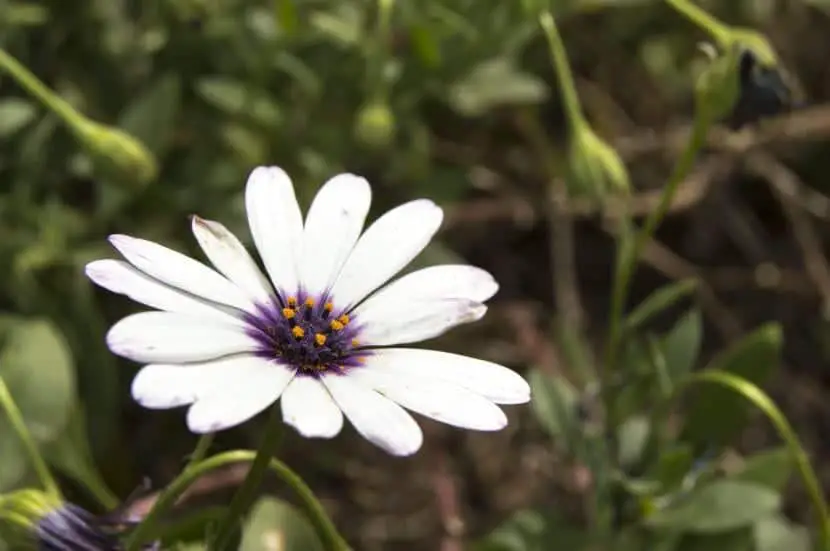
The dimorphoteca it is a very beautiful flowering plant, easy to care for and adaptable. In fact, I can tell you from experience that once it has been planted in the ground for a year, it withstands drought well … and in my area it only rains in spring and autumn for a few days.
So if you are starting to do your garden and / or you want a plant that does not give you problems, I’ll tell you about her nextthe most suitable flower for beginners.
Origin and characteristics

Our protagonist it is a perennial herbaceous plant -lives several years- native to southern Africa. It belongs to the botanical genus Dimorphoteca, which is where one of the common names comes from: dimorfoteca. It is also known as the African margarita or Cape margarita. There are 21 accepted species of the 49 described, the most common being the Dimorphotheca ecklonis.
It can grow to a maximum height of 1 meterand about 2m in diameter. The base of the stems can be woody, which means that it can grow straight, although over the years it tends to have a drooping or creeping bearing. The leaves are alternate, simple, elliptical, with serrated or entire margins. The flowers are grouped in inflorescences called chapters that measure up to 80mm in diameter; and the fruit is smooth, obovoid and triangular, 7x3mm.
What are their cares?

If you want to have a copy, we recommend that you provide it with the following care:
Location
It is important that it is placed outside, in full sun. It does not have invasive roots, but if you want it to have a creeping bearing, I advise planting it at a distance of at least 1 meter from any other plant.
Earth
- Flower pot: universal culture substrate mixed with 30% perlite. You can get the first here! and the second here!.
- the garden: it can grow in all types of soils, even calcareous ones. But if it is very compact it is better to make a hole of about 50cm x 50cm, and mix the soil that you have removed with two or three handfuls of perlite to improve drainage.
Irrigation
The frequency of irrigation will depend a lot on the climate and the location, but it is necessary to take into account at all times that it is well resistant to drought. Therefore, in principle it will be watered:
- Potted: 2-3 times a week in summer, and every 4-5 days the rest of the year.
- In the garden: during the first year twice a week, and once every seven days the rest of the year. From the second year on, the frequency of irrigation can be reduced to the point of suspending irrigation.
Subscriber
From early spring to late summer It is advisable to fertilize Dimorphoteca with specific fertilizers for flowering plants or with Organic fertilizers following the instructions specified on the package. Use liquid products if you are going to have it in a pot so that there are no drainage problems.
Multiplication
Seeds

It multiplies by seeds in spring or early summer. The way to proceed is as follows:
- First you have to fill a seedbed (it can be a flowerpot, a container of milk, a glass of yogurt, … anything that is waterproof and that has or can have some holes in the base for the water to come out) with substrate of universal cultivation.
- Then, you have to water thoroughly, moistening the entire substrate well.
- Next, the seeds will be placed on the surface, ensuring that they are as far apart as possible. It is not necessary to put many in the same seedbed since otherwise many would come together, and successfully separating them would be very difficult. To give you an idea, it is not recommended to put more than two seeds in pots of 10,5cm in diameter.
- The next step is to cover the seeds with a thin layer of substrate, mostly so that they are not directly exposed.
- Finally, it is watered again, this time with a sprayer, and the seedbed is placed outside, in full sun.
This way they will germinate in 2-3 weeks.
Tiller
It multiplies by tillers in spring. The clump is a set of stems that are born from the same foot. The way to proceed is as follows:
- First you have to look for one that is growing healthy.
- Then he scratches the earth around him a bit.
- It is then carefully removed.
- Finally, it is planted in a pot with a universal growing medium and watered.
Placed in semi-shade, it will start to grow on its own in 2 to 3 weeks at the most.
Plagues and diseases
It’s very tough. But if it is watered excessively the roots rot easily, which would lead to the appearance of fungi. To avoid this, you have to control the risks.
Rusticity
The Dimorphoteca withstands frost well down to -4ºC. In colder areas it behaves like an annual.

What did you think of this plant? You have someone?
